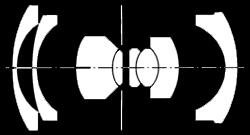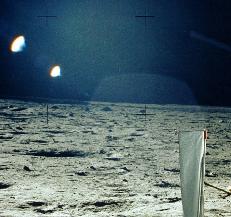lens flare







|
All but the very simplest cameras have compound lenses composed of several small lens elements. Zoom lenses and high-end professional lenses may have many components. When light strikes a glass surface, most of the light passes through the glass (refracts) but a little bit of it reflects off of it. In compound lenses, light can bounce between the lens components and create spots of light on the final photograph. If the light source is behind or to the side, not much light from it falls directly on the lens. This is what you want. You want your light to bounce off your subject and into your lens. But if you point your lens so that the light source shines into it a little, you'll get a lens flare.
|
|
The dotted horizontal line represents the optical axis. The curved white shapes are the lens elements. Each is a precisely ground disc of glass with the cross-section shown, coated with transparent anti-reflective coatings. The vertical lines represent the f-stop aperture.
Some of the lens elements are fixed in position in the lens barrel. Others are mounted in a moveable frame attached to the focus ring. They can move backward and forward along the optical axis to change the focus.
Ironically the Biogon lens was chosen because it was the wide-angle lens least susceptible to focal and chromatic distortion. Correcting for that can only be accomplished by having the many lens elements shown in the diagram. The number of elements increases the chance that a lens flare will occur.
|
The large irregularly shaped area of increased brightness is a reflection of the aperture, the mechanical device adjusted by the f-stop control (see Exposure).
The streak at the upper right is probably the reflection of another internal component.
The soft-edged patch of brightness taking up the top part of the sky is the image of light striking some substance on the lens. It could be the anti-reflective coating, or more likely fine lunar dust on the lens. The astronauts had to constantly brush the camera lenses to keep dust from accumulating on them.
 But the lenses used on
the Apollo missions were the finest available, custom made by
But the lenses used on
the Apollo missions were the finest available, custom made by 


